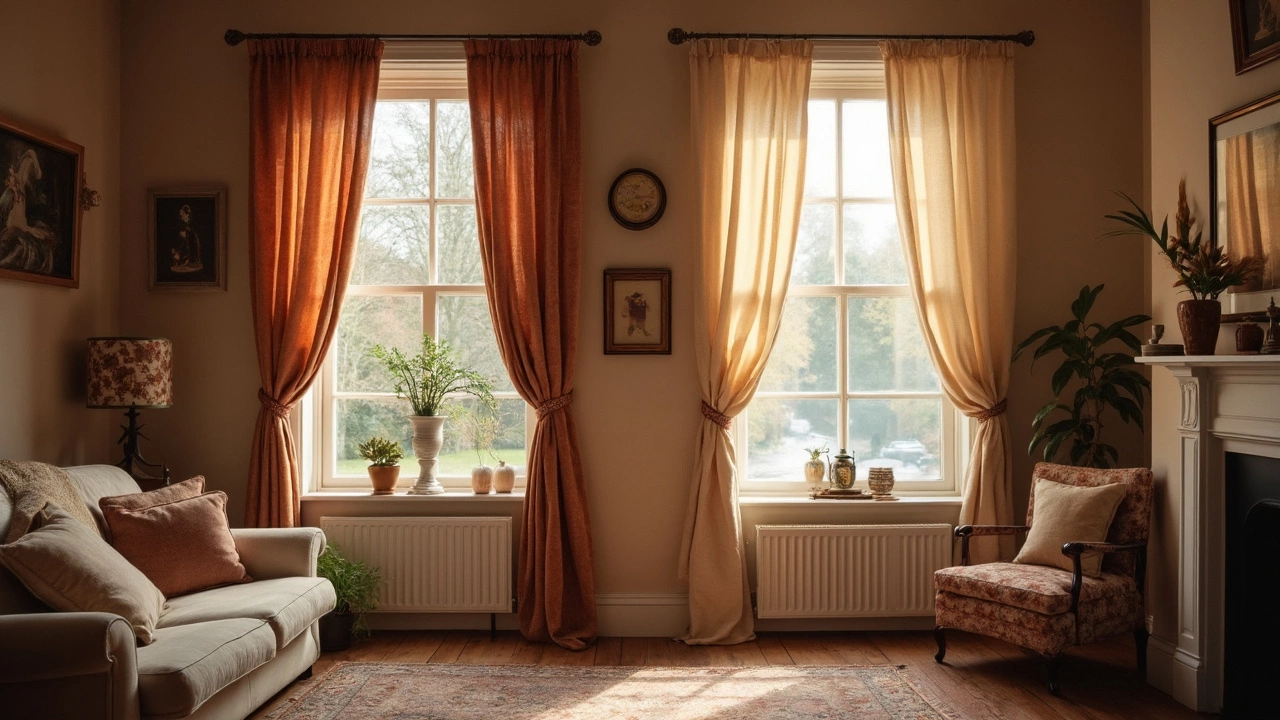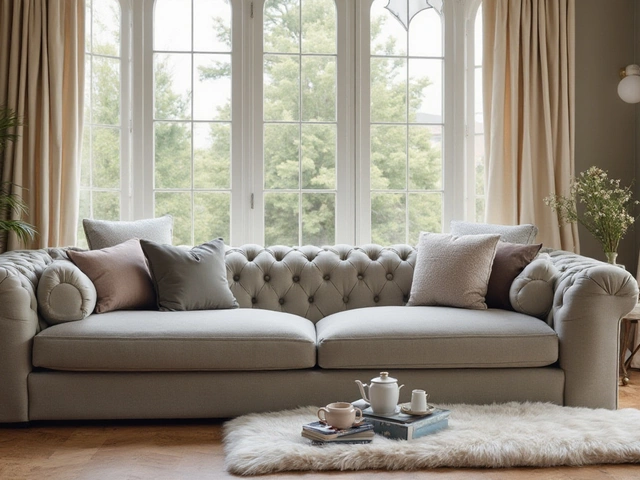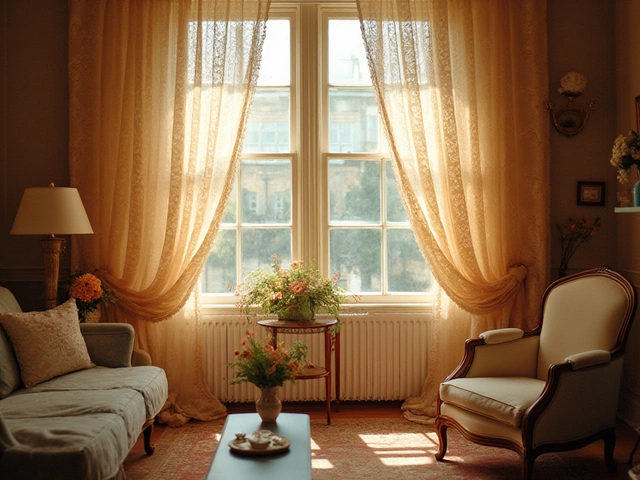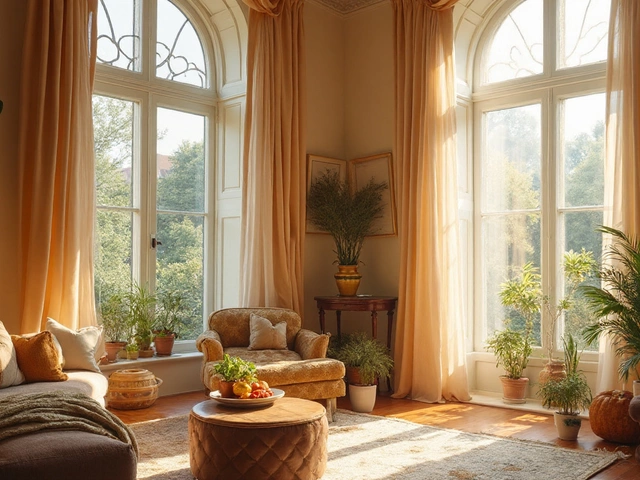Picture this: your living room needs a little sprucing up and those old curtains just aren't cutting it anymore. You might be wondering, 'How close to the floor should they actually be?' It's one of those details that can make or break the vibe of your space.
Let's talk curtain lengths. You've basically got three main styles to think about—hovering just above the floor, gently kissing it, or going for a dramatic puddling effect. Each brings something different to the table, depending on what atmosphere you're after. But get this—a lot of folks don't realize how much the fabric type can sway their decision. Some materials hang better with some lengths because of their weight and how they fall, neat huh?
So how do you avoid that awkward 'not-quite-there' look? A good start is grabbing a trusty tape measure and getting the length sorted before you even hit the stores or online. Seriously, measuring right can save so much hassle! Oh, and let's not forget other sneaky little pitfalls, like choosing a fabric that doesn’t match the curtain style you envision.
- Understanding Curtain Length Options
- The Case for Floor-Length Curtains
- Measuring for the Perfect Length
- Fabric Types and Their Impact
- Avoiding Common Curtain Hanging Mistakes
- Personalizing Your Curtain Style
Understanding Curtain Length Options
When it comes to dressing up your windows, the length of your curtains is a big deal. This isn't just about covering windows; it's about setting a tone for your space. So, what are your options?
First up is the floor-length curtain that stops a smidge above the floor. We're talking about a half-inch off the ground, perfect for achieving a tidy look. This style works wonders in homes with kids or pets because it won't drag on the floor and get dirty.
Then there's the length that just kisses the floor. Imagine your curtain just touching the floor like it’s gently saying hello. It's a polished style and super popular because it gives a tailored appearance without much fuss. You still get that elegant vibe without worrying about them getting underfoot.
For those who love a bit of drama, there are curtains that puddle. This means the fabric extends several inches onto the floor, creating a 'puddle' effect. It’s definitely a statement, making rooms look luxurious—ideal for areas where you’re aiming for elegance, like a formal dining room.
It's good to weigh pros and cons based on your lifestyle. Check out this quick comparison:
| Style | Pros | Cons |
|---|---|---|
| Just Above Floor | Clean look, low maintenance | May not suit overly formal spaces |
| Floor Kissing | Elegant, neat, adaptable | Requires precise measurements |
| Puddling | Luxurious, dramatic effect | Needs more upkeep, not pet-friendly |
By knowing your options, you can pick what suits your style and space best. Curtain height is more than aesthetics—it's about practicality and lifestyle compatibility. Make sure you're choosing based on what feels right for your home and peace of mind.
The Case for Floor-Length Curtains
When it comes to choosing curtains, letting them hang right to the floor is a popular choice for a few solid reasons. First off, floor length curtains can make your room look taller and more put-together. Neat trick, right? They draw the eye upwards and create a sense of height, which is especially handy in rooms with lower ceilings.
Going floor-length isn't just about looks, though. It's also about function. Full-length curtains are better at blocking light and providing insulation. Those chilly drafts that sneak in during winter? A good set of full-length curtains can help keep your home cozy. Plus, having them reach the floor cuts down on weird light gaps that shorter curtains can't cover.
There's another perk to consider. With curtain height reaching the floor, you can keep dust at bay. Shorter curtains tend to collect dust underneath them, meaning more cleaning hassle. Let’s face it, nobody's got time for more chores!
And if you’re a bit of a mix-and-match fan, floor-length curtains offer so much versatility. You can play with puddling—where the fabric gently gathers on the ground—for a lush, luxurious look. It's all about your style preference and how much drama you want to add to the room.
But before you rush out and grab any curtains that promise this magic, remember this: the key is in the measuring. Because we all know nothing's worse than realizing your curtains hang awkwardly mid-air or spill too much onto the floor, creating a tripping hazard. Make sure to nail those measurements before anything else!
Measuring for the Perfect Length
Alright, so you're ready to create some serious ambiance with those curtains. But before you grab your wallet, let's get the measuring tape out and make sure you're not playing a guessing game. Nailing the curtain height is crucial.
First things first, you need to decide on where you want your curtains to end. Are you looking for that ultra-clean look that barely hovers above the floor? Or maybe you're all about that dramatic puddle? Either way, measure from the top of the curtain rod to where you’d like them to end.
If you're going for that chic floor-length curtain style, aim for them to just graze the floor—give it around 1/2 inch of space to avoid constant dragging and dirt collection. For the ‘puddle’ look, add around 3-6 inches to your total length for that extra fabric flair.
Here's a quick step-by-step to get that precision:
- Hang the rod where you want it. It should typically be about 4-6 inches above the actual window to give the illusion of height.
- With a tape measure, start from the top of the rod or if you already have a specific hook, start from there.
- Measure all the way down to your desired endpoint—floor or otherwise.
- Note down your measurements—you'd be surprised how many forget this step.
Oh, don't overlook the rod’s position. The width of your rod can also affect how the curtains hang, especially if they're heavy. Be sure to double-check brackets are secure to hold everything up.
At the end of the day, taking a few extra minutes to measure properly makes all the difference between professionally stylish and DIY disaster. Get it right, and your curtains will be the talk of the room.
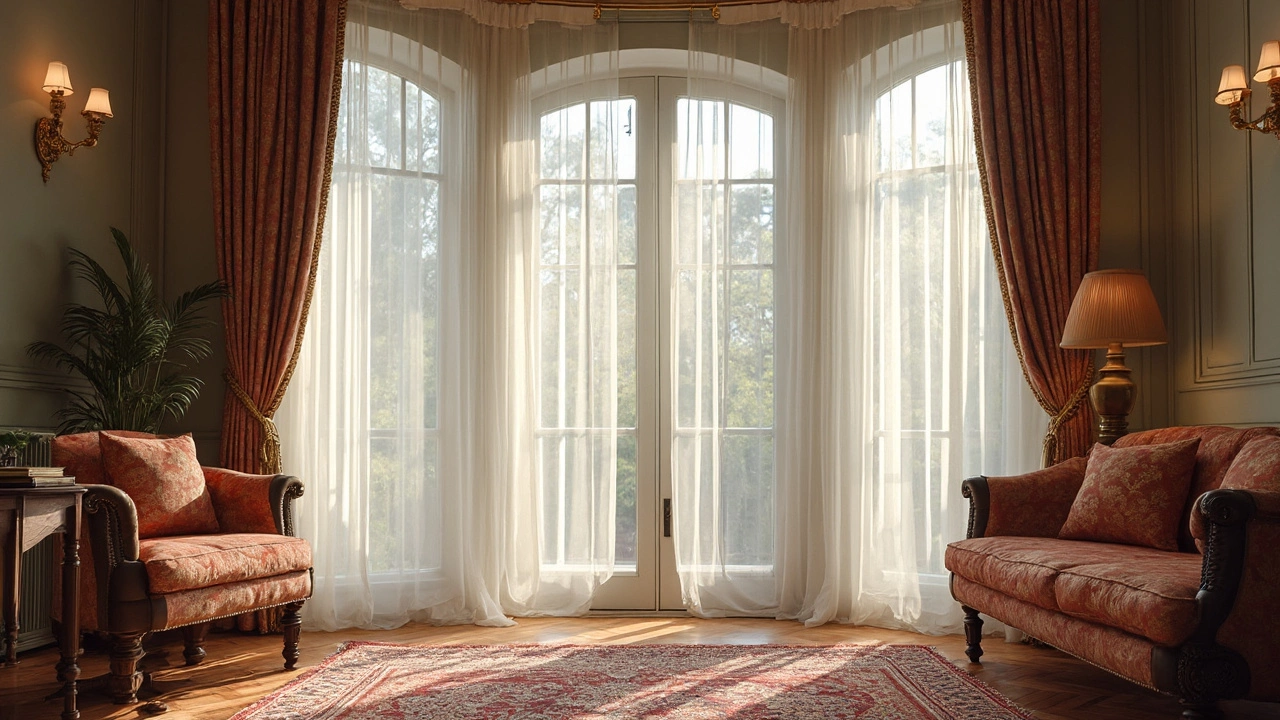
Fabric Types and Their Impact
When it comes to curtains, the fabric you pick really changes the game. You might think all materials are pretty much the same, but they aren't. Let's start with heavy fabrics like velvet or brocade. These are perfect if you're looking for floor length curtains that hang nicely and give your room a plush, dramatic feel. Plus, they’re a solid choice for keeping out the chill during colder months.
Then there's cotton, which is super versatile. It’s light enough to work well in breezy environments, like a casual living room or even a kitchen. Cotton operates in that Goldilocks zone—not too heavy, not too light. This makes it great for spaces where you don’t want the windows to feel too weighed down or too airy.
For those who love a touch of glam, silk is your go-to. It brings a bit of elegance that can really elevate a room’s style. But here's the kicker: silk is kind of high maintenance. It’s best to keep them away from too much sunlight as they can fade over time. They also look amazing when they slightly kiss the floor, giving a chic and polished look.
- Light Fabrics (like linen or sheer): Ideal for areas needing natural light.
- Heavy Fabrics (like velvet): Perfect for achieving that cozy, insulated vibe.
- Medium Fabrics (like cotton): Offers a balanced look for everyday use.
So before you grab the first cute pattern you see, take a sec to think about what works best in your space. Does the room have a lot of sunlight? Is it more formal or laid back? Answering these questions can save you time and give you the perfect set of curtains that align with both your style and practical needs.
Avoiding Common Curtain Hanging Mistakes
Getting curtain placement right might seem easy, but oh boy, the pitfalls trip up a lot of us. Don't worry though, I've got your back with some straightforward tips to dodge those blunders.
First up, floor length curtains are all about precision. One big mistake is hanging them too high or too low. You don’t want them awkwardly hovering too far off the floor or dragging underfoot. Aim for about half an inch above the floor for the perfect length. It's like a sweet spot that prevents dust gathering yet looks sleek.
Another common slip is picking the wrong rod height. For a dramatic look, place the rod closer to the ceiling rather than just above the window. This trick not only gives the illusion of height—your room will feel way more open!
Also, pay attention to curtain width. Curtains should be wide enough to cover the window completely when closed. Think of a nice two to three times the width of your window. Scrunched-up or too-stretched curtains just aren’t the vibe.
- Incorrect measuring: Always double-check your measurements. It's best to measure both the window and the space above it to ensure accuracy.
- Poor curtain style selection: Fabric and style should fit your room's purpose. Think sheer options for lighter, more breezy spaces. Heavier ones work well in colder months or for better insulation.
- Overlooking light control: Consider how much sunlight you want peeking through. Blackout curtains can be crucial for bedrooms, while lighter options might suit a living room better.
Did you know that a study found over 60% of people hang their curtains without a complete plan? Yup, and that often leads to time-consuming adjustments. You aren't alone if you feel the struggle is real, but now you're equipped to get it right!
Personalizing Your Curtain Style
Alright, you've got your curtain lengths down, but how do you make them truly yours? Personalizing your curtains can transform a room into a reflection of your style and taste. The good news is, it doesn't require a design degree, just a few tips and tricks!
First things first, consider your room's color scheme. Curtains can either blend with your existing palette or stand out as a bold statement piece. If you're going for a soft, cozy vibe, choose colors that are harmonious with your walls and furniture. For a pop of drama, go bold with vibrant or contrasting colors.
- Patterns vs. Solids: Do you love a classic striped look, or are you drawn to florals or geometric designs? Patterns can add visual interest, while solid colors tend to bring a more serene feel.
- Hardware Selection: Curtain rods and finials might seem insignificant, but they can enhance the room’s overall style. Think about finishes like brushed nickel for a modern look or antique bronze for a vintage touch.
- Lining or No Lining: Lined curtains add fullness and can help with insulation and light blockage. On the flip side, unlined curtains allow for a breezier feel and more light in the room.
If you're still unsure, consider your lifestyle. Do you have pets or small kids? In that case, easy-to-wash fabrics might be a priority. Or maybe you want to embrace trends, like sheer curtains that let in tons of light, which is perfect for a minimalist approach.
A neat little trick is to mix and match. Who says you can’t use both a bold head drape and more subtle sheers beneath? This combo adds depth to any window treatment and can be switched up as your style evolves.
